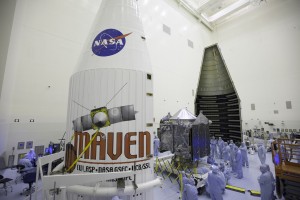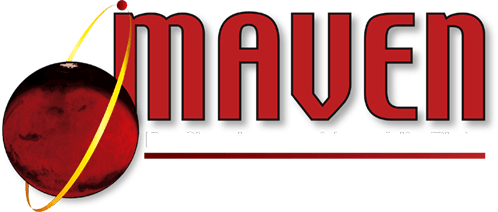
NASA’s next Mars explorer soon will leave Earth on a mission to answer one of the Red Planet’s greatest conundrums: If our arid celestial neighbor once had a thicker atmosphere and a surface flowing with water, as evidence suggests, how did the climate change so dramatically?
MAVEN is slated to launch Nov. 18 aboard a United Launch Alliance Atlas V rocket from Launch Complex 41 on Cape Canaveral Air Force Station (CCAFS) in Florida.
The scientists and managers behind the mission gathered in a Kennedy Space Center clean room Sept. 26 to get an up-close look at the MAVEN spacecraft, and to share their enthusiasm with reporters and photographers.
“After 10 years of working on this, I can’t tell you how excited I am to see this finished spacecraft ready to go,” said the mission’s principal investigator, Bruce Jakosky, as he stood in front of MAVEN’s outstretched solar panels in the high bay of Kennedy’s Payload Hazardous Servicing Facility.
Jakosky, of the Laboratory for Atmospheric and Space Physics (LASP) at the University of Colorado at Boulder, leads the mission and has been involved in the flight since its inception. The mission is designed to search for clues into the thinning of Mars’ atmosphere and the disappearance of surface water over time. Scientists theorize the sun may have had a role in the escape of gas from the planet’s upper atmosphere — a region that hasn’t yet been studied.
Since 1964, NASA has flown a series of orbiters, landers and rovers to Mars, searching for chemical traces of water or signs that the planet once could harbor life. MAVEN stands apart from these because it’s the first to focus exclusively on the upper reaches of the planet’s atmosphere.
“Mars is a complicated system, just as complicated as the Earth in its own way,” Jakosky said. “You can’t hope, with a single spacecraft, to study all aspects and to learn everything there is to know about it. With MAVEN, we’re exploring the single biggest unexplored piece of Mars so far.”
The spacecraft will arrive at the Red Planet on Sept. 22, 2014, and slip into an elliptical orbit ranging from a low of 93 miles above the surface to a high of 3,728 miles. It also will take five “deep dips” during the course of the mission, flying as low as 77 miles in altitude and providing a cross-section of the top of the atmosphere.
MAVEN is an eight-foot cube weighing about 5,400 pounds at launch — as much as a fully loaded sport utility vehicle. With its twin pairs of gull-wing-shaped solar panels extended, it stretches 37 feet from wingtip to wingtip.
The spacecraft is outfitted with a trio of instrument suites. The Particles and Fields Package, built by the University of California at Berkeley Space Sciences Laboratory, contains six individual instruments that characterize the solar wind and ionosphere of the planet. The Remote Sensing Package, built by LASP, will determine global characteristics of the upper atmosphere and ionosphere. The Neutral Gas and Ion Mass Spectrometer, built by NASA’s Goddard Space Flight Center, will measure the composition and isotopes of neutrals and ions.
Assembled by Lockheed Martin in Denver, Colo., MAVEN was blasted with sound waves, shaken on a vibration table, even put through a thermal vacuum test using liquid nitrogen to simulate the cold of space and hot lamps to mimic the sun — all to ensure it was ready for the extremes of liftoff and spaceflight. Finally, the spacecraft was loaded onto an Air Force C-17 cargo aircraft and delivered to the Florida spaceport.
NASA’s Launch Services Program oversees all aspects of launch management, including preflight processing, integration activities, countdown and liftoff. The program is headquartered at Kennedy.
MAVEN’s Atlas V rocket is a reliable workhorse with a history of success for NASA missions — including the Mars Science Laboratory mission featuring the Curiosity rover. The rocket’s booster and upper-stage components arrived at the Florida spaceport not long after the spacecraft.
While the Atlas V was readied for flight in a hangar at the Atlas Space Operations Center, or ASOC, on the Air Force station, MAVEN was sent to Kennedy’s Payload Hazardous Servicing Facility for one last round of checkouts, tests and closeouts.
The processing team faced one significant challenge with less than two months until liftoff: a 17-day government shutdown that briefly halted prelaunch activities. But because activities had been running slightly ahead of schedule and some team members were able to quickly return to work, the shutdown did not interfere with launch plans.
“It’s kind of like a hurricane,” said NASA Launch Director Omar Baez. “We have hurricane plans, but we don’t have a government shutdown plan. So that’s a hurdle. We overcame it, we’re moving forward, and we’re ready to hit the beginning of the window.”
MAVEN’s 20-day launch window opens Nov. 18. Managers and controllers from NASA’s Launch Services Program, United Launch Alliance and the U.S. Air Force, along with the spacecraft team, will report to their consoles in launch control for the countdown.
When countdown clocks tick down to zero and the Atlas V roars to life, MAVEN’s mission finally will be under way, but the next big milestone comes later — when the spacecraft is released from the rocket’s upper stage.
MAVEN’s caretakers on the ground will wait anxiously for the spacecraft to report it is healthy and headed to Mars.
“That’s the moment when we can celebrate, when everybody gets up, shouts, and shakes hands,” said Baez.
Planning the MAVEN mission has been a team effort involving several partners. NASA Goddard in Greenbelt, Md., manages the project and provided two of the science instruments for the mission. Lockheed Martin built the spacecraft and is responsible for mission operations. The University of California at Berkeley’s Space Sciences Laboratory provided science instruments for the mission. NASA’s Jet Propulsion Laboratory in Pasadena, Calif., provides navigation support, Deep Space Network support, and Electra telecommunications relay hardware and operations.
“The spacecraft is symbolic of the hundreds of people that have been a part of this since Day One, and all kinds of support that’s needed to get us here,” said David Mitchell, MAVEN project manager at Goddard.
With liftoff right around the corner, team members are eagerly anticipating the start of the mission and the promise of solving another of Mars’ riddles.
“We’re really excited,” Mitchell said. “We’re so close now. I mean, we’re headed to Mars.”
To read the original NASA Kennedy release, please visit: http://www.nasa.gov/content/maven-seeks-to-solve-another-mars-riddle
By Anna Heiney
NASA’s John F. Kennedy Space Center
[addthis]

